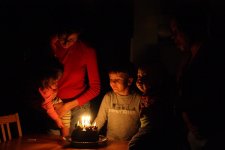Daneinbalto
Established
I have attached a shot done with a dSLR and -1-2/3 EV compensation. If I don't compensate, the candles blow out not only their own pixels but also the nearby ones, making the cake look like a volcano. Is this amount of compensation also what you would have used? How much do you correct color balance? (if you compensate fully it will look unnatural). Any other tips for shooting this situation?
Any chance of taking a similar shot handheld on 400 ISO film? (Portra NC with a RF and 50 mm f/2). If so, should I compensate by as much (-1-2/3 EV)?.
The attached dSLR photo was taken at f/2.8, 1/80, ISO 3200. RAW to JPG in Canon DPP with no color correction.
Any chance of taking a similar shot handheld on 400 ISO film? (Portra NC with a RF and 50 mm f/2). If so, should I compensate by as much (-1-2/3 EV)?.
The attached dSLR photo was taken at f/2.8, 1/80, ISO 3200. RAW to JPG in Canon DPP with no color correction.
Attachments
Last edited:


